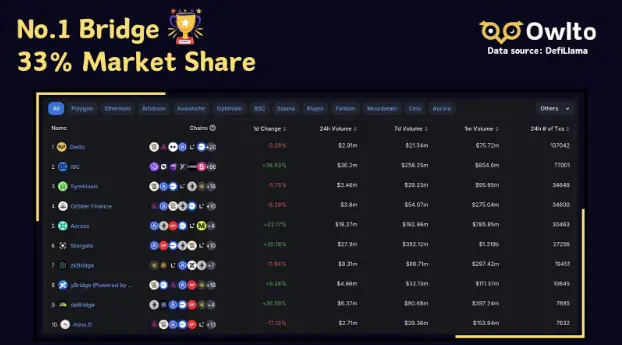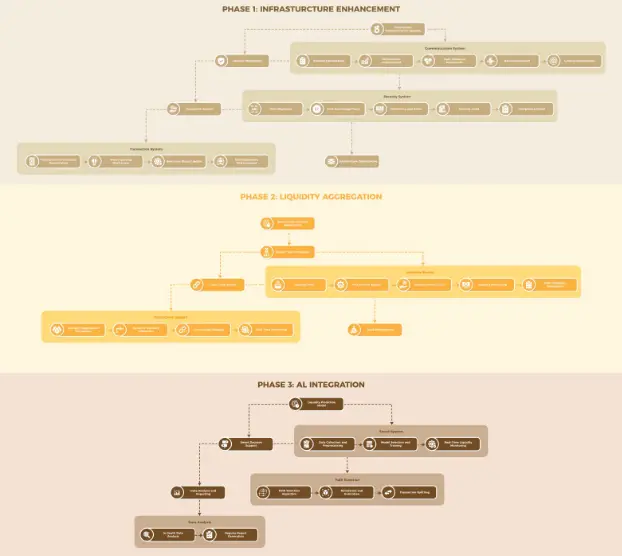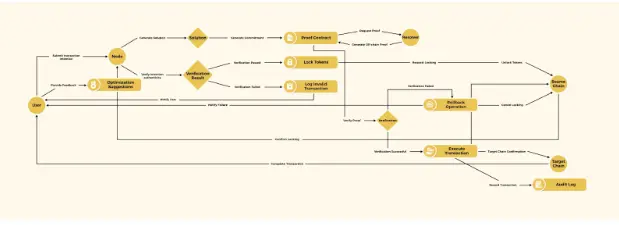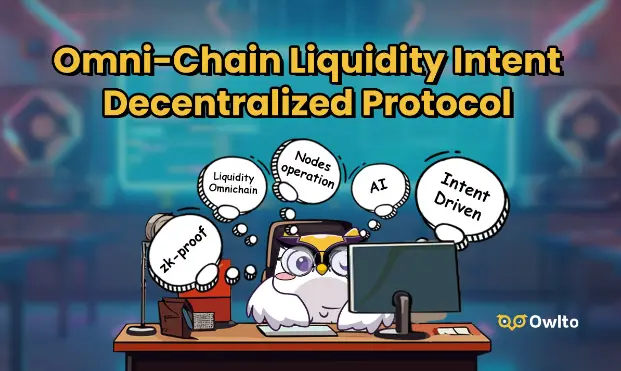Multi-Chain Coexistence — An Inevitable Trend in Blockchain Development
With the rapid development of blockchain technology, more and more teams are establishing their own blockchains to gain economic benefits and attract more users. This trend not only showcases the diversity of blockchain technology but also reflects the market's demand for various application scenarios.
Although some high-performance public chains attempt to enhance the performance of a single chain to meet developers' needs, they still face limitations in handling transaction volumes and reliability. For instance, during peak times, some public chains may experience congestion, leading to extended transaction confirmation times and, in extreme cases, downtime issues. These problems not only harm user experience but also challenge developers' confidence.
Moreover, as blockchain applications increase, single-chain solutions cannot meet all demands. Different application scenarios may require different technical architectures and execution environments. For example, financial applications may prioritize transaction speed and security, while gaming applications may focus more on low latency and high throughput. This necessitates that future blockchain ecosystems provide diverse execution environments to support the flexibility and scalability of various blockchain applications.
As technology continues to advance and market demands change, we expect to see more types of execution environments emerge. These environments will not only include high-performance public chains but may also feature dedicated chains, side chains, Layer 2 solutions, etc., to meet the needs of various applications. Through these diverse execution environments, the blockchain industry will better address current challenges, promote further technological development, and facilitate the widespread adoption of applications.
What Stage Are We Currently In Within the Multi-Chain Landscape?
In the multi-chain ecosystem, Ethereum, as one of the earliest smart contract platforms, still plays a key role. With the launch of Arbitrum and Optimism's Ethereum rollup scaling solutions, Ethereum Layer 2 (L2) solutions have flourished, aiming to enhance Ethereum's processing capacity and reduce transaction costs to meet the growing user demand and application scenarios.
The replicability of technology has made it possible to quickly create new chains: there are already over 50 chains based on the OP Stack Superchain, and Arbitrum Orbit's Layer 3 also has more than 50 chains at different stages of development. Additionally, other Layer 2 solutions based on zk-rollup technology are also thriving. These innovations not only enhance Ethereum's scalability but also provide developers with more choices, further enriching Ethereum's ecosystem.
However, this rapid growth has also led to the issue of liquidity fragmentation. Various L2 networks compete for total value locked (TVL), further dispersing Ethereum's liquidity. Vitalik Buterin pointed out on his personal Twitter that the main challenge Ethereum currently faces is the fragmentation of operations between different L2s. This fragmentation not only reduces the efficiency of liquidity utilization but also increases the complexity for users when trading across different platforms.
In addition to Ethereum, other Layer 1 public chains such as Solana, Sui, and BSC are also rising in competition, forming a multi-chain landscape where Ethereum leads and other public chains coexist. Each Layer 1 ecosystem has seen the emergence of multiple Layer 2 solutions, such as several L2s spawned from the inscription craze in the Bitcoin ecosystem, Appchains, SVM Rollups, and side chains on Solana, as well as L2 layouts on public chains like BSC and TON. This multi-chain development trend has led to limited cryptocurrency market funds being dispersed across numerous chains, resulting in serious liquidity fragmentation issues.
There Is Still Much Room for Optimization in Market Solutions
Current cross-chain bridges can help users bridge assets, but the user experience is often unsatisfactory, specifically manifested in:
- Complex Operations: Users need to switch between multiple websites, connect wallets, approve transactions, and wait for confirmations, increasing the operational burden on users.
- Time Delays: Cross-chain transfers may take anywhere from several seconds to a few minutes, affecting the timing of transactions, especially in volatile market conditions where delays can lead to user losses.
- Insufficient Liquidity: Users may encounter unfavorable prices during cross-chain transfers, making losses unpredictable, and liquidity acquisition between different chains becomes more challenging.
- Security Risks: Cross-chain transactions are seen as a weak link in the blockchain ecosystem, with multiple security incidents (such as Wormhole, LI.FI, Across, etc.) highlighting this issue, leading to decreased user trust in cross-chain transactions.
Although existing solutions have alleviated liquidity issues to some extent, they still have significant limitations. Theoretically, concentrating all cryptocurrency market liquidity in a centralized exchange (CEX) could provide the best user experience, but this approach contradicts the principles of decentralization and is difficult to implement in practice. In this context, the emergence of DEX aggregators has improved user experience within a single chain; however, they face new challenges in a multi-chain environment. Current DEX aggregators can only aggregate liquidity on a single chain and cannot achieve cross-chain liquidity aggregation, making it difficult for users to trade across different chains. Additionally, on high gas fee networks like Ethereum, the cost of transferring liquidity across chains is often higher than directly using liquidity sources, further limiting user choices.
While the DEX aggregator model performs more effectively on low-cost, low-latency networks like Solana, it still cannot fully resolve the liquidity fragmentation issue in a multi-chain environment. Therefore, the industry urgently needs more innovative solutions to achieve more efficient cross-chain liquidity aggregation and enhance the overall trading experience for users.
To overcome these challenges, the industry needs more innovative solutions, especially in cross-chain interoperability and liquidity integration. With continuous technological advancements and ecosystem improvements, the blockchain industry is expected to achieve more efficient asset flow and a better user experience. Future solutions may include smarter cross-chain bridging technologies. Technological innovations will provide users with a safer and more convenient cross-chain trading experience, promoting the widespread application of blockchain technology.
Owlto Finance: An Innovative Full-Chain Liquidity Solution
To address these challenges, Owlto Finance has proposed the concept of "intent-based full-chain liquidity trading," aiming to simplify the cross-chain trading process. Users only need to submit a request containing their trading intent, and the system automatically integrates liquidity pools across chains to achieve efficient asset conversion and minimize trading friction costs. This innovative solution is expected to significantly improve user experience, providing a decentralized, secure, and transparent trading environment while achieving optimal trading costs and time efficiency within a deeply unified liquidity pool.
Owlto Finance has become a leader in the cross-chain bridge sector within just one year: with over 2 million users across more than 200 countries and regions; it consistently ranks among the top three in cross-chain 24-hour trading volume on DefiLlama, with a peak market share of 33%. As a leader in the cross-chain field, Owlto Finance is committed to solving cross-chain trading and liquidity issues, leveraging its outstanding technical strength and market influence. To date, Owlto Finance has successfully completed over 100,000 cross-chain transactions, with active user numbers exceeding 2 million. By integrating advanced technology and innovative solutions, Owlto Finance provides users with efficient and secure cross-chain trading experiences, aiming to effectively address the challenges posed by liquidity fragmentation.

Owlto Finance will gradually achieve the goal of full-chain liquidity trading through a three-phase strategic plan. Each phase focuses on enhancing and integrating key technologies to ensure the efficiency, security, and user experience of cross-chain trading.
- Infrastructure Enhancement: Improve the efficiency and security of cross-chain bridges, simplify the transaction confirmation process, and ensure a smooth experience for users during transactions.
- Full-Chain Liquidity Pool Integration: Achieve single-chain liquidity aggregation, support smart contracts for cross-chain trading, ensure the accuracy and timeliness of liquidity data, and integrate liquidity pools across multiple chains to enhance the depth and efficiency of cross-chain trading while ensuring the security of liquidity interoperability.
- AI Integration: Utilize AI technology to enhance the intelligence of liquidity management and trading path optimization, achieving real-time liquidity forecasting and personalized trading suggestions.
Through this series of phased measures, Owlto Finance is committed to providing users with efficient and secure cross-chain trading experiences, addressing the challenges posed by liquidity fragmentation.

Phase One: Ensuring the Security of Full-Chain Asset Flow Through ZK and Node Security Verification
In the crypto world, "decentralization" and "security" have always been the top principles. The cross-chain field still faces challenges regarding "security" and "privacy protection." According to DefiLlama, as of now, over $2.8 billion has been stolen from cross-chain bridges, accounting for nearly 40% of the total stolen funds in the entire Web3 industry. Therefore, the transmission and storage of transactions must possess a high level of security to prevent data from being tampered with or stolen. At the same time, while on-chain transaction transparency is high, it may also expose users' trading intents, leading to privacy risks.
To address this, Owlto Finance is introducing the following two solutions to tackle the issues of "security" and "privacy protection":
- Node Security Verification: Decentralized solutions effectively avoid single points of failure, thereby enhancing the security of asset flow between different networks. Owlto's "node security verification" employs a staking mechanism based on a decentralized consensus mechanism, introducing "node penalty mechanisms" and "node incentive mechanisms" to ensure data security. If a node transmits fraudulent data, its staked tokens will be penalized (Slashing mechanism); while nodes that actively participate and execute honestly not only earn additional rewards through staking but also receive transaction fee sharing and token incentives for successfully executing trading paths. This design ensures that nodes maintain honest behavior in a decentralized environment, preventing malicious actions.
- Zero-Knowledge Proof: By introducing zero-knowledge proof technology, it ensures that verifiers can confirm user intent and execute transactions correctly without knowing specific transaction information. If an intermediary attempts to transmit a forged protocol, the generated commitment will fail verification, thereby ensuring the security of the entire transaction process and protecting user privacy. Additionally, during the verification phase, zero-knowledge proofs can also prevent maximum extractable value (MEV) attacks, further enhancing the system's security.
In addition, Owlto Finance will also focus on enhancing the efficiency, security, and user experience of cross-chain bridges, with specific measures including:
- Simplifying Cross-Chain Communication: Implementing advanced cross-chain communication protocols to reduce data transmission delays and improve transaction speeds.
- Enhancing Security: Introducing multi-signature mechanisms to ensure the integrity and tamper-resistance of transactions, while employing zero-knowledge proof technology to protect user privacy and prevent data leaks.
- Optimizing Transaction Confirmation: Streamlining the transaction confirmation process to shorten confirmation times and improve user experience; implementing smart queuing and priority processing mechanisms to reduce transaction congestion; providing real-time transaction status updates to enhance user visibility into transaction progress.
- Improving Scalability: Adopting a distributed system design to ensure high concurrent processing capabilities and designing a modular architecture to support future feature expansions and upgrades.
Phase Two: Integrating Full-Chain Liquidity Through Interoperability
In this phase, Owlto Finance is committed to creating an interoperability solution for Web3 users to achieve full-chain asset liquidity. This goal is not easy; how does Owlto plan to achieve it?
Owlto provides a full-chain liquidity pool that enhances interoperability between different chains. For users, the stronger the interoperability features and the more chains connected, the richer the scenarios for asset circulation. Particularly by bridging different ecosystems and connecting EVM and non-EVM heterogeneous chains, users can circulate funds from Chain A on Chain B with minimal friction, thereby improving the circulation and utilization efficiency of these assets in DeFi.
Currently, Owlto's full-chain liquidity pool has connected over 50 networks, successfully facilitating asset liquidity between ecosystems such as Ethereum, Bitcoin, and Solana, expanding the application scenarios of assets across different networks and increasing the potential for returns. Owlto has completed over 1.6 million cross-chain transactions on Bitcoin L2, while the number of cross-chain transactions on other chains is approximately 8 million, with a total user count exceeding 2 million.
At the same time, Owlto has significantly improved user experience in terms of cross-chain speed and security, with 90% of cross-chain transactions completed within 30 seconds and receiving an AA rating on the CertiK security audit website.
Owlto Full-Chain DEX Aggregation: Compared to regular DEXs, DEX aggregators act more like information trackers, capable of finding the best liquidity pools across different networks, thus enabling trades with reduced slippage and avoiding high slippage issues caused by limited liquidity pools. Owlto has deployed DEX aggregator functionality on approximately 20 chains, facilitating liquidity between different chains and tokens.
Through this series of measures, Owlto Finance has achieved comprehensive integration of multiple chain liquidity pools, enhancing the depth and efficiency of cross-chain trading. Specific measures include:
- Establishing Liquidity Aggregation Mechanisms: Designing and implementing liquidity aggregation mechanisms to consolidate liquidity resources across chains, ensuring interoperability of liquidity pools and reducing trading slippage and price discrepancies.
- Smart Contract Management and Scheduling: Automating the management and scheduling of cross-chain liquidity to achieve dynamic liquidity allocation and optimize resource utilization.
- Cross-Chain Liquidity Bridging: Achieving liquidity interoperability between different chains through liquidity bridging, ensuring the security and efficiency of cross-chain liquidity.
- Real-Time Monitoring: Establishing a real-time monitoring system to track the status and changes of liquidity pools. Liquidity Reading and Integration: Developing tools and interfaces to read and integrate liquidity data on a single chain in real-time, ensuring the accuracy and timeliness of liquidity data to support cross-chain transactions.
Phase Three: Utilizing AI Technology to Achieve Intent-Centric Full-Chain Liquidity Trading
In this phase, Owlto Finance will introduce an Intent-Centric trading model, which differs from traditional trading methods by not being confined to specific paths to complete transactions. Instead, it allows for transactions to be executed through any path, as long as the user's constraints are met and the expected results are achieved.
Within this framework, users only need to sign a transaction intent, expressing their expectations for the final outcome. Protocol nodes will be responsible for evaluating different liquidity providers across multiple blockchain networks, including decentralized exchanges (DEXs) and market makers. Through smart routing and algorithms, nodes will select the optimal cross-chain liquidity path, ensuring that the transaction results align with user intent. During this process, the user's assets will be held in a smart contract, and funds will only be released to the liquidity provider upon successful transaction completion, thereby ensuring the safety of user funds.
For example, suppose a user wishes to convert 1000 USDT on Ethereum to BNB on the BNB Chain, aiming to receive at least 1.2 BNB. After the user submits the transaction intent, the protocol will analyze data and market conditions using AI algorithms to find the best path. The possible operation flow could be: first exchanging USDT for ETH on Arbitrum, then transferring ETH to the BNB Chain, and finally exchanging ETH back to BNB on the BNB Chain. Once the node selects the best path, the transaction will begin execution. This method can more effectively utilize liquidity pools and advantageous exchange rates across chains while reducing transaction costs and time.

In this "Intent-Centric Full-Chain Liquidity Trading" model, AI technology plays a crucial role:
- Liquidity Prediction: Analyzing historical data and current market conditions through AI algorithms to predict liquidity changes across different chains, allowing for proactive adjustments to liquidity pool configurations. Nodes can utilize liquidity resources from multiple chains to optimize transaction execution.
- Path Optimization: AI algorithms will be used to find the best trading paths, ensuring users receive the highest quality liquidity while minimizing transaction costs and time. If necessary, transactions may be split into multiple smaller parts and executed through multiple paths to ensure optimal liquidity utilization and cost minimization.
- Data Analysis and Reporting: Conducting in-depth analysis of cross-chain transaction data to generate detailed reports and insights, helping protocol developers and users better understand market dynamics and liquidity conditions.
Through these measures, Owlto Finance will leverage AI technology to enhance the intelligence of liquidity management and trading path optimization, specifically including:
- Liquidity Prediction Model Development: Developing and training AI models to analyze historical data and market trends, providing real-time liquidity change predictions to support dynamic adjustments to liquidity pool configurations.
- Trading Path Optimization: Integrating AI algorithms to analyze trading data and market conditions, optimizing trading paths to improve transaction execution efficiency.
- Intelligent Decision Support: Utilizing AI to generate trading suggestions and strategies, assisting user decision-making and providing personalized trading optimization plans to enhance user experience. Continuous Learning and Improvement: Implementing machine learning mechanisms to continuously update and optimize AI models, collecting user feedback and market data to improve the accuracy and efficiency of AI algorithms.

Through this series of AI-driven measures, Owlto Finance will further enhance the efficiency and security of full-chain liquidity trading, providing users with a superior trading experience.
Owlto Finance: The Leader in Full-Chain Liquidity Trading
Owlto Finance has become a leader in the cross-chain field, dedicated to solving the current issues of cross-chain and liquidity fragmentation through full-chain liquidity solutions. Our technological upgrades enable liquidity aggregation to provide users with multiple advantages:
- Enhancing User Experience: By providing a unified user interface, users can easily access and manage assets across different chains. This consistency not only improves operational efficiency but also enhances the overall user experience. Liquidity aggregation allows users to access liquidity pools across multiple chains on a single platform, reducing the need to switch between different platforms and simplifying the trading process.
- Improving Trade Execution: Liquidity aggregators can find the best prices among multiple liquidity sources, providing users with better trade execution, lowering transaction costs, and enhancing the overall user experience. Enhancing Market Efficiency: Liquidity aggregation reduces market fragmentation by consolidating these dispersed liquidity sources, improving overall market efficiency. By aggregating liquidity across different chains, liquidity aggregators can increase the utilization of liquidity pools and reduce wasted idle funds.
- Supporting Cross-Chain Interoperability: Liquidity aggregation supports cross-chain trading in chain abstraction, enabling users to seamlessly exchange assets between different blockchains. This capability is crucial for the interoperability of multi-chain ecosystems. By optimizing trading paths and reducing intermediary steps, liquidity aggregators can lower the costs of cross-chain transactions, allowing users to perform cross-chain operations at lower fees.
- Increasing Trade Reliability: Liquidity aggregators reduce the risks of transaction failures and price slippage by selecting optimal liquidity paths and execution strategies. By providing transparent information on trade execution and liquidity sources, liquidity aggregators can enhance user trust in the trading process.
Although the current DeFi ecosystem still has many inconveniences and security risks, Owlto Finance's vision is to build an intent-centric full-chain liquidity protocol. We will integrate intent, zero-knowledge proofs, smart contracts, and AI technology, using transaction splitting algorithms and intelligent trading routing algorithms to help users obtain the best liquidity across multiple chains and choose the optimal paths to reduce transaction costs. Through secure and decentralized methods, Owlto Finance is committed to addressing the complexities of full-chain trading and the inadequacies of market liquidity, providing better services for billions of users.
免责声明:本文章仅代表作者个人观点,不代表本平台的立场和观点。本文章仅供信息分享,不构成对任何人的任何投资建议。用户与作者之间的任何争议,与本平台无关。如网页中刊载的文章或图片涉及侵权,请提供相关的权利证明和身份证明发送邮件到support@aicoin.com,本平台相关工作人员将会进行核查。





